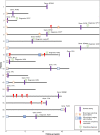The genetic basis of apparently idiopathic ventricular fibrillation: a retrospective overview
- PMID: 37967257
- PMCID: PMC10665040
- DOI: 10.1093/europace/euad336
The genetic basis of apparently idiopathic ventricular fibrillation: a retrospective overview
Abstract
Aims: During the diagnostic work-up of patients with idiopathic ventricular fibrillation (VF), next-generation sequencing panels can be considered to identify genotypes associated with arrhythmias. However, consensus for gene panel testing is still lacking, and variants of uncertain significance (VUS) are often identified. The aim of this study was to evaluate genetic testing and its results in idiopathic VF patients.
Methods and results: We investigated 419 patients with available medical records from the Dutch Idiopathic VF Registry. Genetic testing was performed in 379 (91%) patients [median age at event 39 years (27-51), 60% male]. Single-gene testing was performed in 87 patients (23%) and was initiated more often in patients with idiopathic VF before 2010. Panel testing was performed in 292 patients (77%). The majority of causal (likely) pathogenic variants (LP/P, n = 56, 15%) entailed the DPP6 risk haplotype (n = 39, 70%). Moreover, 10 LP/P variants were found in cardiomyopathy genes (FLNC, MYL2, MYH7, PLN (two), TTN (four), RBM20), and 7 LP/P variants were identified in genes associated with cardiac arrhythmias (KCNQ1, SCN5A (2), RYR2 (four)). For eight patients (2%), identification of an LP/P variant resulted in a change of diagnosis. In 113 patients (30%), a VUS was identified. Broad panel testing resulted in a higher incidence of VUS in comparison to single-gene testing (38% vs. 3%, P < 0.001).
Conclusion: Almost all patients from the registry underwent, albeit not broad, genetic testing. The genetic yield of causal LP/P variants in idiopathic VF patients is 5%, increasing to 15% when including DPP6. In specific cases, the LP/P variant is the underlying diagnosis. A gene panel specifically for idiopathic VF patients is proposed.
Keywords: Genetic testing; Idiopathic ventricular fibrillation; Sudden cardiac arrest.
© The Author(s) 2023. Published by Oxford University Press on behalf of the European Society of Cardiology.
Conflict of interest statement
Conflict of interest: P.G.P. is an associate editor of Europace and was not involved in the peer review process or publication decision. S.-C.Y. is a consultant for Boston Scientific and has received lecture fees and research grants from Medtronic, Biotronik, and Boston Scientific. All remaining authors have declared no conflicts of interest.
Figures




Comment on
-
Genetics in Probands With Idiopathic Ventricular Fibrillation: A Multicenter Study.JACC Clin Electrophysiol. 2023 Aug;9(8 Pt 1):1296-1306. doi: 10.1016/j.jacep.2023.03.008. Epub 2023 May 24. JACC Clin Electrophysiol. 2023. PMID: 37227348
References
-
- Visser M, van der Heijden JF, Doevendans PA, Loh P, Wilde AA, Hassink RJ. Idiopathic ventricular fibrillation. Circ Arrhythm Electrophysiol 2016;9:1–11. - PubMed
-
- Zeppenfeld K, Tfelt-Hansen J, de Riva M, Winkel BG, Behr ER, Blom NAet al. . 2022 ESC guidelines for the management of patients with ventricular arrhythmias and the prevention of sudden cardiac death developed by the task force for the management of patients with death of the European Society of Cardiology (ESC). Eur Heart J 2022;43:3997–4126. - PubMed
Publication types
MeSH terms
Supplementary concepts
Grants and funding
LinkOut - more resources
Full Text Sources
Medical
Miscellaneous

